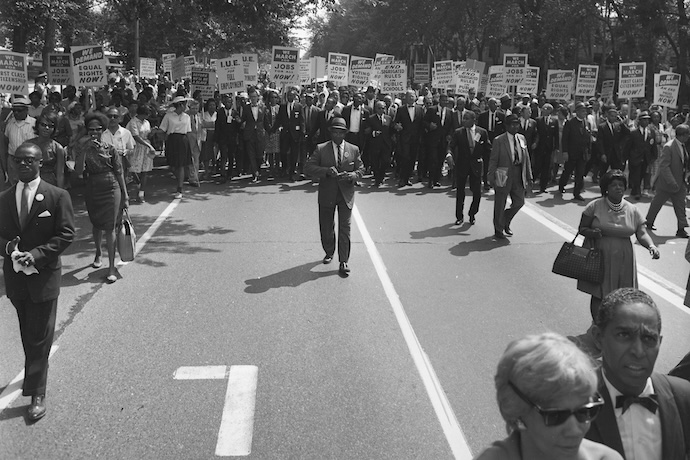Over the last 20 years, major American denominations, particularly those with southern origins (such as the Southern Baptist Convention and the Pentecostal Holiness Church), have been in the business of passing “racial reconciliation resolutions.”
The Southern Baptists did so with a pretty strong statement in 1995; the Pentecostals experienced their “Memphis Miracle” in 1994 (perhaps the most ironic here, given the interracial origins of Pentecostalism in the early 20th century); and numerous other groups followed in the wake, mostly apologizing for slavery and segregation in the deeper past. By the turn of the century, this seemed to have been a done deal.
I was surprised recently to then see tweets praising God for an “Overture on Pursuing Racial Reconciliation” just passed at the predominantly southern General Assembly of the Presbyterian Church of America (PCA). The vote was 861 in favor, 123 opposed. The authors and supporters of the Overture were, understandably, gratified.
Meanwhile, the same Assembly created a committee to study the issue of women in the ministry, a subject of greater ideological division and pain. The difference in those two outcomes suggests much about how far conservative American Protestants have come, and how far they have to go.
(Note: an “overture” is a somewhat technical Presbyterian term that effectively means “resolution.” For simplicity I’ll use the informal term “resolution” below).
The PCA denomination originally formed only in 1973 (preceding a merger with some smaller Presbyterian groups that considerably increased its size in 1982), partly as a result of Presbyterian church splits in the 1960s. The relatively recent advent of the PCA as a denominational organization compelled some to ask, upon the resolution’s original consideration in 2015, whether denominations should apologize for “racial acts they didn’t commit,” since the denomination proper didn’t exist in the 1960s. But of course the history of the individual churches, and white southern Presbyterians more generally, went much deeper than the formation of one organization in 1973.
“Black and white students and other participants in the kneel-ins to desegregate churches consistently spoke of their commitment to enacting the ideal of the “Fatherhood of God and the Brotherhood of Man” at the churches, while white southern churchgoers often saw them as ‘agitators.’”
The continued theological differences separating the main body (the Presbyterian Church of the United States of America, or PCUSA) and the PCA are quickly highlighted here. In terms of theology, the division is a fairly typical moderate/liberal versus conservative religious split. In part, the Presbyterian schism was over questions of church organization (“polity”) and theology (a long-running theme in American Presbyterian history, with more splits and divorces than those in a Trump-Gingrich ticket).
Put more simply, most large evangelical denominations effectively have a blue church/red church divide.
The schism was also a direct result of resistance from various churches in the 1960s to being told by Presbyterian leadership to admit African Americans into their congregations. The story here—focusing on Memphis as a case study—is told in gripping detail in Stephen Haynes’s remarkable work The Last Segregated Hour: The Memphis Kneel-Ins and the Campaign for Southern Church Desegregation.
The resolutions just passed originated from the work of the religious history scholar (and PCA minister) Sean Michael Lucas, who literally wrote the book on the denomination’s history, and J. Ligon Duncan, professor of Systematic and Historical Theology and Chancellor at Reformed Theological Seminary in Jackson, Mississippi. In particular, Lucas’ careful historical work has brought together into one story the origins of the PCA both in terms of theology and in terms of “social issues” (particularly race).
Originally posed for consideration at the 2015 PCA meeting, Lucas subsequently posted his thoughts on the issue and multicultural aspirations for the church here, and provided a balanced historical perspective on differing historical views within the church here. By June 2016, the Overture passed easily, despite criticism by some in the church that the resolution had more to do with the “racial grievance industry” than with the changes the PCA already had undergone over the last generation.
The resolution reads, in part:
. . . the 44th General Assembly of the Presbyterian Church in America does recognize, confess, condemn and repent of corporate and historical sins, including those committed during the Civil Rights era, and continuing racial sins of ourselves and our fathers such as the segregation of worshipers by race; the exclusion of persons from Church membership on the basis of race; the exclusion of churches, or elders, from membership in the Presbyteries on the basis of race; the teaching that the Bible sanctions racial segregation and discourages inter-racial marriage; the participation in and defense of white supremacist organizations; and the failure to live out the gospel imperative that “love does no wrong to a neighbor” (Romans 13:10);
and Be it further resolved, that this General Assembly does recognize, confess, condemn and repent of past failures to love brothers and sisters from minority cultures in accordance with what the Gospel requires, as well as failures to lovingly confront our brothers and sisters concerning racial sins and personal bigotry, and failing to “learn to do good, seek justice and correct oppression” (Isaiah 1:17); and Be it further resolved, that this General Assembly praises and recommits itself to the gospel task of racial reconciliation, diligently seeking effective courses of action to further that goal, with humility, sincerity and zeal, for the glory of God and the furtherance of the Gospel.
Such statements make a remarkable contrast to the story of church segregation and kneel-ins told in Haynes’s work. “To hell with Christian principles—we’ve got to save the church,” one church elder in Birmingham in the mid-1960s responded when challenged at a church meeting on how to deal with African American students seeking to worship at his church. “Leave the Bible out of this. Read The Rise and Fall of the Roman Empire, and you’ll see what’s happening here,” a church elder in Tuskegee, Alabama said in 1965.
Black and white students and other participants in the kneel-ins to desegregate churches consistently spoke of their commitment to enacting the ideal of the “Fatherhood of God and the Brotherhood of Man” at the churches, while white southern churchgoers often saw them as “agitators” who sought to make “political” or “sociological” points and publicly embarrass the churches—a foretaste of those who find the current resolution to arise from a “racial grievance industry.” Since the protestors were, by this way of thinking, operating from impure motives, they could be cast out of the church.
Those who objected to the official policy of the Presbyterian Church of the United States in the 1960s felt that the denomination had forsaken the historic Presbyterian policy of the “spirituality of the church.” That policy, to dismantle “Negro” presbyteries and synods and desegregate the church, dated only from 1957, arising in part as a direct response to the Little Rock school episode. Many (not all, but a majority) of white southern Presbyterians resisted to one degree or another.
Some eventually had a change of heart. Others connected desegregation to the broader trends of liberalism that they saw destroying the true Presbyterian Church. They made the ever-popular slippery slope argument—once you give up orthodoxy in one area, the church will inevitably decline into lackadaisical liberalism in all areas. This remains the firewall argument for denominational religious conservatives generally, often with a nod to statistics showing the decline of the mainline and growth or at least relative stability of “conservative” church organizations (a trendline that is less true now than it was before). That makes the recent movement on reinterpreting race and religion in these denominations all the more compelling to study.
“What were once seen as timeless truths about race turn out to be culturally captive.“
Taken together with the Southern Baptist Convention’s resolutions about the Confederate flag—and other examples that could be drawn from the racial reconciliation discussions within American denominations—one may ask what it means that discussions of race have again come to the forefront of theologically conservative American Christianity.
The demographic changes leading to the “de-Europeanization of American Christianity” obviously have something to do with it. The PCA itself, a church deeply steeped in the history of the white South, is comprised today of about 20 percent non-white parishioners, for example. A similar number holds for Southern Baptists. This puts them about mid-point on the scale derived from a Pew study of “most and least racially diverse religious groups.” So does the rise to leadership of younger church leaders raised in a post-civil rights history shed of some of the mythologies of the past.
Posts from the African American Reformed Network, especially this one, are helpful here. Jemar Tisby, director of the African American Leadership Initiative at the Reformed Theological Seminary, writes:
The overture on racial reconciliation will not abruptly change the culture of an entire denomination. Anyone who thinks otherwise is ripe for disappointment. At the same time, approving this statement makes a statement. It says to people both within and outside the PCA that we stand against racism in all its forms and commit ourselves to solidarity with other image-bearers across racial and ethnic lines. My hope is that this overture will set us on a course to increase ethnic diversity and participation in the denomination in the near future. This should be used as an opportunity to go back to our individual churches and press the issue of racial reconciliation. Every elder and member of the Presbyterian Church in America is in the midst of a moment that can catalyze a movement for racial justice in the church.
Or, as Lucas puts it, “Our great hope is that the PCA of 2035 would be a genuinely multiracial church, both in our local congregations and in our higher courts.”
The tough but real progress made in an honest grappling with American racial history within these major denominations is a heartening part of the remapping of American Christianity. One remaining question for the future is what the outcome of resolutions and study committees and the like will be towards gender and sexuality. There, the language and reasoning often follows the same logic as an older generation of thought about race. What were once seen as timeless truths about race turn out to be culturally captive. A community committed to scriptural orthodoxy sees the biblical teachings differently now than it did then; that seems a likely outcome at some future point, perhaps soon, when the scriptural reasoning for culturally shaped, gendered norms is historicized.





